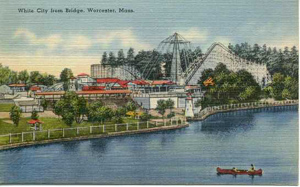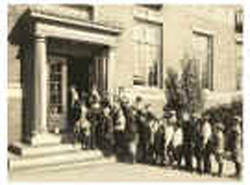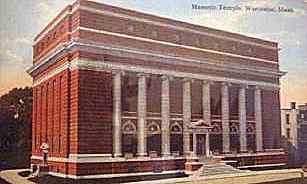R & R in the Village
With the war worlds away
in Europe and the Pacific, residents of Quinsigamond forged the bonds
of a tightly knit community in the dance halls, on the playing fields,
in fraternal organiztions, as well as in various clubs and social organizations.
White City provided an additional escape from a work-a-day world.
For employees of American Steel & Wire, the company's facilities were
available for parties, movies, and athletic events. Wray
Schelin was raised by his grandparents in Quinsigamond. His grandfather
enjoyed a long tenure at American Steel & Wire -a fifty year career
in which reportedly he was never once late for work. On the occasion of
their fiftieth wedding anniversary, the Schelins celebrated with a big
party at the company's assembly hall. "Yeah. Yeah, we had every party…
and my grandmother, grandfather married many, many years ago… fifty
years we had a big party there. All the beer was kept in a wash bucket-a
big bucket. They had no refrigeration then. And the sandwiches… rough
and tumble sandwiches… slice of bread and throw it on, throw the
meat there." Eleanor
Rudge remembers fondly the frequent dances held at American Steel
& Wire on Saturday nights: "They'd have someone come and play
the organ or play the piano, and they'd come on Saturday nights because
the people couldn't go anywhere and they couldn't drive-even the public
transportation-they were cut down too on rationing, you know, and, it
was kinda, it was kinda nice though when I think back. We all stayed together.
We knew everybody."

Townspeople did more than their fair share in making Quinsigamond as enjoyable
a place to grow up as any. For those who could not afford to travel to
the Boys' Club in downtown Worcester, or were not linked to American Steel
& Wire, many baseball and basketball teams were sponsored by area
churches and businesses. Quinsigamond summers were filled with baseball
games at Greenwood Park. In the winter, there was skating at Old Jefford's
Pond, located just outside of the Village. Mrs.
Rudge remembers: "Yeah, on the weekend they would go light fires
to warm up, roast marsh-mellows and everyone would skate around there."
Skating was so popular that the local fire department would freeze the
street so local children could skate as soon as the temperatures dropped.
 For
those who could afford the costs of getting there, White City was an enjoyable
respite from everyday village life. Located on Lake Quinsigamond, the
amusement park offered a number of different attractions. There was the
water ride, "Shoot-the-Chutes," the miniature railway, a "House
of Trouble" maze, and even a coaster called "the Zip" (as
seen in the photo). The Park also offered an opportunity for dancing.
At the time, the latest fad in dance halls was becoming the "dance
'til you drop" competition. The Spanish Villa Ballroom was often
the venue for these marathon competitions. (27)
Evelyn Grahn remembers
attending one of these events as a teenager: "That was when I was
in high school and one of my aunts said, I'd love to go down to White
City and watch them because they were on their feet dragging and the music
was playing. So, ah, she said, when you get out of high school today,
I'll be down in the city, she lived in Greendale, so, we went down on
the trolley car to White City and sat all afternoon on bleachers looking
at these poor people stumbling around."
For
those who could afford the costs of getting there, White City was an enjoyable
respite from everyday village life. Located on Lake Quinsigamond, the
amusement park offered a number of different attractions. There was the
water ride, "Shoot-the-Chutes," the miniature railway, a "House
of Trouble" maze, and even a coaster called "the Zip" (as
seen in the photo). The Park also offered an opportunity for dancing.
At the time, the latest fad in dance halls was becoming the "dance
'til you drop" competition. The Spanish Villa Ballroom was often
the venue for these marathon competitions. (27)
Evelyn Grahn remembers
attending one of these events as a teenager: "That was when I was
in high school and one of my aunts said, I'd love to go down to White
City and watch them because they were on their feet dragging and the music
was playing. So, ah, she said, when you get out of high school today,
I'll be down in the city, she lived in Greendale, so, we went down on
the trolley car to White City and sat all afternoon on bleachers looking
at these poor people stumbling around."
 With
transportation not being as readily available then as it was now, young
residents of Quinsigamond relied on a few well-established organizations
in Worcester for fraternization. The Worcester Boys' club was particularly
popular among Quinsigamond youth. The Club had two locations, one on Ionic
Avenue- the one frequented by most Quinsig boys- and one at Lincoln square.
At each location, for as little as 25 cents, boys could engage in a wide
range of structured activities. Members could play sports, take vocational
classes, or even study in the club's library. (28)
According to Gordon
Forsberg, the rivalry between Lincoln Square and Ionic Avenue clubs
was the stuff of legend: "… that was a great rivalry between
Ionic Ave. Boys' club and Lincoln Square there, that brought a lot of
rivalry stuff, which is pretty nice when you're a kid." In addition
to the Boys' clubs, boys could join the one of 90 Boy Scout troops in
Worcester. Quinsigamond had its very own troop during the war, which operated
out of the Salvation Army hall. (29)
As today, the Boy Scouts emphasized duty to country and traditional religious,
moral and community values which must have resonated among youth of the
highly traditional, conservative village.
With
transportation not being as readily available then as it was now, young
residents of Quinsigamond relied on a few well-established organizations
in Worcester for fraternization. The Worcester Boys' club was particularly
popular among Quinsigamond youth. The Club had two locations, one on Ionic
Avenue- the one frequented by most Quinsig boys- and one at Lincoln square.
At each location, for as little as 25 cents, boys could engage in a wide
range of structured activities. Members could play sports, take vocational
classes, or even study in the club's library. (28)
According to Gordon
Forsberg, the rivalry between Lincoln Square and Ionic Avenue clubs
was the stuff of legend: "… that was a great rivalry between
Ionic Ave. Boys' club and Lincoln Square there, that brought a lot of
rivalry stuff, which is pretty nice when you're a kid." In addition
to the Boys' clubs, boys could join the one of 90 Boy Scout troops in
Worcester. Quinsigamond had its very own troop during the war, which operated
out of the Salvation Army hall. (29)
As today, the Boy Scouts emphasized duty to country and traditional religious,
moral and community values which must have resonated among youth of the
highly traditional, conservative village.
 While preoccupied with their worklives during the war, Quinsigamond adults
also participated in a range of social organizations. Many Quinsigamond
men joined the Freemasons, a major fraternal organization, and met at the
Morning Star Lodge across the street from the Boys' Club. Their Wives could
join the Masons' affiliate group Eastern Star while their sons and daughters
could join De Molay and the Rainbow Girls. Other men established informal
social or athletic clubs, such as the "Auburn Tennis Club," of
which Edward Hult was
a founding member. (32) But Quinsigamond
women participated in one of the most celebrated national organizations
of World War II: The United Service Organization (USO). The USO provided
a place for servicemen and women to socialize and engage in recreational
activities. Across the country, over 3000 clubs were established and staffed
by over 1,000,000 volunteers. Worcester's USO center at 201 front street
catered to over 65,000 military personnel during the war. (33)
Herbert Berg recalls
his wife's involvement in the organization: "I know that down at the
YWCA (Young Women's Christian Association) my wife used to go to the USO
dances and YWCA used to be on Chatam street. And they had different things
for the servicemen."
While preoccupied with their worklives during the war, Quinsigamond adults
also participated in a range of social organizations. Many Quinsigamond
men joined the Freemasons, a major fraternal organization, and met at the
Morning Star Lodge across the street from the Boys' Club. Their Wives could
join the Masons' affiliate group Eastern Star while their sons and daughters
could join De Molay and the Rainbow Girls. Other men established informal
social or athletic clubs, such as the "Auburn Tennis Club," of
which Edward Hult was
a founding member. (32) But Quinsigamond
women participated in one of the most celebrated national organizations
of World War II: The United Service Organization (USO). The USO provided
a place for servicemen and women to socialize and engage in recreational
activities. Across the country, over 3000 clubs were established and staffed
by over 1,000,000 volunteers. Worcester's USO center at 201 front street
catered to over 65,000 military personnel during the war. (33)
Herbert Berg recalls
his wife's involvement in the organization: "I know that down at the
YWCA (Young Women's Christian Association) my wife used to go to the USO
dances and YWCA used to be on Chatam street. And they had different things
for the servicemen."While some could afford trips to White City and outings in downtown Worcester, the majority of villagers found plenty to keep them amused in the village. Visiting relatives, walking to Millbury Street for an ice cream, and even an occasional Sunday drive were ways those who chose to stay in the village amused themselves, provided there wasn't a baseball game or skating event in the works. All told, the residents of the village successfully made it an enjoyable place to live, especially for children. Forsberg, who was 11 when America entered the War, adds that in his mind, "there was no better place to be brought up."